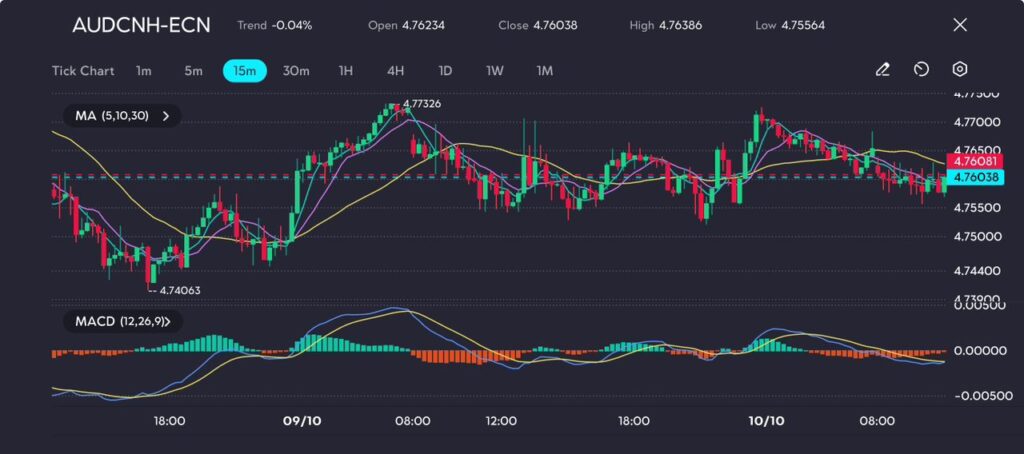Key Points:
- AUDUSD fell 0.4% to $0.6716, continuing a five-session losing streak.
- The kiwi hit a seven-week low, pressured by increased expectations of RBNZ rate cuts.
The Australian dollar extended its decline on Thursday, dropping 0.4% to $0.6716 amid weakening investor sentiment driven by the lack of fresh stimulus news from China.
This marks the fifth straight session of losses, pushing the Aussie closer to its 200-day moving average of $0.6627.
The Australian economy’s dependence on China has left the currency vulnerable as Chinese officials have yet to introduce substantial stimulus measures, leading to further declines in key commodity prices such as iron ore.

Picture: AUD/CNH consolidates near 4.7600, awaiting a breakout as traders eye key support and resistance levels, as seen on the VT Markets app.
Technical Analysis
AUD/CNH closed at 4.76038, with a slight dip of 0.04% during the session, as the pair saw low volatility.
Price action remained largely range-bound between a high of 4.76386 and a low of 4.75564, suggesting a lack of strong directional momentum.
The moving averages (5, 10, and 30-period) are clustering tightly around the current price, reflecting consolidation without a clear bullish or bearish trend emerging.
The MACD (12, 26, 9) also signals indecision, with the MACD line crossing the signal line but with very little histogram movement, indicating weak momentum.
Support is evident near 4.74063, while resistance is seen around 4.77326. A break below support could signal a further drop, while a move above resistance could point to renewed bullish strength.
Given the current technical indicators, the pair is likely to remain in this consolidation phase until a breakout from the current range occurs.
Kiwi Feels the Heat
The kiwi dollar also faces pressure, falling to a seven-week low of $0.6050 after the Reserve Bank of New Zealand (RBNZ) introduced a 50 basis-point rate cut.
Expectations are growing that the RBNZ might even introduce a 75 basis-point cut in November, which sent the NZD below the 200-day moving average of $0.6096.
You might like: Kiwi Hits 7-Week Low as RBNZ Eases Policy
The broader direction of both currencies hinges on the U.S. consumer inflation data due later today. A higher-than-expected CPI figure could dampen hopes for a Federal Reserve rate cut in November.
Futures markets now imply just a 20% chance of the Fed maintaining rates next month, especially after a stronger-than-expected jobs report.
Analysts, including Kyle Rodda, emphasise the U.S. dollar’s resurgence, driven by economic outperformance and the fading prospects of Chinese fiscal stimulus.
Despite the Aussie’s current struggles, analysts at HSBC remain optimistic, citing the currency’s low valuation and expectations of coordinated fiscal and monetary policy support from China.
They argue that the true impact will come from sustained policy efforts rather than immediate results, keeping some hopes alive for a recovery in the Australian dollar.
Start trading now — click here to create your live VT Markets account.









